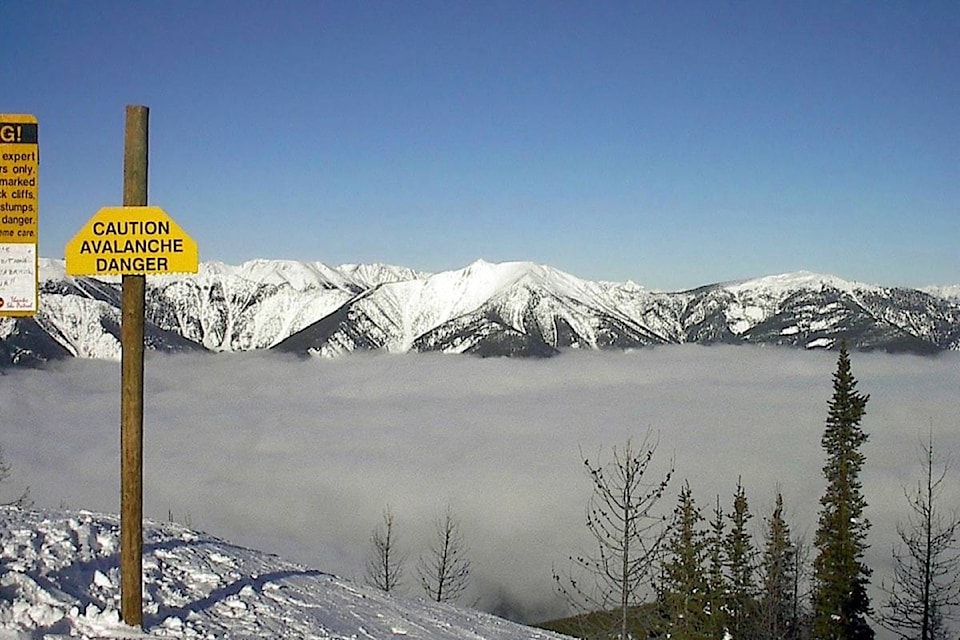Avalanche Canada and Parks Canada issued a Special Public Avalanche Warning for recreational backcountry users last weekend for many parts of the province; and they are warning that those going out into the back country should check conditions and be prepared for emergencies, due to a high threat of avalanches this winter.
A map of the affected region can be found at http://bit.ly/2mk0HWc.
The snowpack in these areas contains a number of weak layers. Recent snowstorms have buried these layers anywhere from 40 cm to more than a metre deep, and the weight of the new snow has brought this unstable snowpack to a critical point, making it very easy for skiers or snowmobilers to trigger large avalanches.
Avalanches kill an average of 10 people a year in this province, according to a 2015 BC Coroner’s report. Almost 70 per cent of those fatalities occur in the Interior, and most of the victims are either snowmobilers or skiers.
Princeton Ground Search and Rescue leader Randy Rorvik is blunt about someone’s prospects for survival if caught in an avalanche.
“You have about 15 minutes to live.”
Danger exists for outdoor enthusiasts who might be hiking, skiing, or snowmobiling in the back country. “Any cutback on a forest service road or a trail has the potential to slide, in my opinion,” he says.
Rorvik urges sportsmen and women to take proper precautions when outdoors, pack essential survival gear, and carry avalanche beacons that can be used by members of a party to locate a fellow traveller under the snow.
Along with specially constructed snow probes and shovels, they could be the difference between life and death. “That’s pretty standard. Any snowmobiler should have them nowadays. There are lots of real stories of how they have saved lives.”
“We have been keeping a close eye on these weak layers and the snow load that has been accumulating on top of them,” explains James Floyer, forecasting program supervisor for Avalanche Canada. “It’s a complex situation and we are now at the tipping point. Warmer temperatures will definitely increase the chances of triggering an avalanche.”
There have been a number of near misses reported over the past two weeks, as well as a fatal avalanche accident north of Fernie on January 8. “Many of these incidents are occurring in what is generally considered fairly safe terrain, such as relatively low-angle slopes, treed areas, and even heavily tracked slopes,” adds Floyer. “These conditions require expert-level decision making skills and we recommend backcountry users avoid avalanche terrain. The signs indicating you are exposed to avalanche terrain can be very subtle. If you don’t have the training to recognize them, please avoid the backcountry or hire a professional guide.”
The provincial government is encouraging anyone exploring the trails, mountains, and backcountry areas of British Columbia to be prepared with suitable equipment, first-aid supplies, and an awareness of the risks. The following safety tips are strongly recommended:
Never travel alone, and make sure you plan ahead. Before heading outdoors, leave a trip plan with family or friends, and stick to it.
Be prepared for the elements with the essentials, such as extra water, layers of clothing, a shelter, and something to start a fire with for warmth overnight.
Carry a signaling device (such as a whistle) so that searchers can find you even if they can’t see you, as well as communication and navigation devices like a fully charged cell phone, compass, and/or GPS unit.
Don’t venture out of bounds or off marked trails, and be aware of how far you’ve gone and when you need to turn back to avoid hiking in the dark. Be aware of the time for sunset, and always carry a flashlight, just in case.
If you become lost, don’t keep moving. Stay put and wait for help. Don’t presume that by moving downhill you will get back on track.
Take conditions into account and plan appropriately. Learn more about avalanche safety and risks, and get the most recent bulletins at www.avalanche.ca.
With files from Andrea DeMeer/Similkameen Spotlight
editorial@accjournal.ca
Like us on Facebook and follow us on Twitter
